Lada Niva
| Lada 4x4 | |
|---|---|
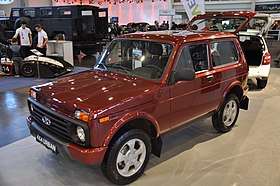 | |
| Overview | |
| Manufacturer | AvtoVAZ |
| Also called |
Bognor Diva (Uruguay) Lada Super 4x4 (Egypt) Lada Bushman (Australia)[1] Lada Cossack (United Kingdom) Lada Fora Lada Hussar (Finland) Lada Job (Italy) Lada Sport (Iceland) Lada Niva (worldwide) Lada Taiga (Germany) VAZ-2121 (Soviet Union/Russia) VAZ Niva Niva 2121 |
| Production | 1977–present |
| Assembly |
Amman, Jordan (LHJ) Quito, Ecuador (Aymesa) Bucharest, Romania (Dunarea) Cherkasy, Ukraine (Bogdan) Cairo, Egypt (Alamal Group) Montevideo, Uruguay (Bognor) Tolyatti, Russia (VAZ, VIS) Thebes, Greece (Automeccanica) Ust-Kamenogorsk, Kazakhstan (Azia Avto)[2] |
| Body and chassis | |
| Class |
Off-road car Compact SUV |
| Body style |
3-door hatchback and 5-door wagon 2-door, 4-door pickup and van |
| Layout | Front-engine, full-time four-wheel-drive |
| Related |
Chevrolet Niva VIS-234600 VIS-234610 VIS-294600 VIS-294601 VIS-294610 VIS-294611 |
| Powertrain | |
| Engine |
1.6l 2106 I4 petrol (1977-1993) 1.7l 21213/4 I4 petrol (1993-present) 1.8l 2131 I4 petrol (1995-present) 1.9l XUD 9SD diesel (1999-2007) |
| Transmission |
4-speed manual (1977-1993) 5-speed manual (1993-present) |
| Suspension | |
| Front | independent suspension with coil springs |
| Rear | 5-link live axle |
| Dimensions | |
| Wheelbase |
2,200 mm (86.6 in) (hatchback) 2,700 mm (106.3 in) (wagon) 2,700 mm (106.3 in) (pickup) |
| Length |
3,740 mm (147.2 in) (hatchback) 4,240 mm (166.9 in) (wagon) 4,520 mm (178.0 in) (pickup) |
| Width | 1,680 mm (66.1 in) |
| Height | 1,640 mm (64.6 in) |
| Curb weight |
1,150 kg (2121) 1,210 kg (21213/21214) 1,350 kg (2131) |
The Lada 4×4, formerly called the Lada Niva (Russian: Лада Нива; Niva (нива) is the Russian word for "field"), is an off-road vehicle designed and produced by the Russian (former Soviet) manufacturer AvtoVAZ specifically for the rural market, although models made for urban use are sold.
It was the first mass production off-road vehicle to feature a unibody architecture, independent front suspension with coil springs, and is a predecessor to current crossover SUVs which nearly all follow this format; it inspired the Suzuki Vitara.[3] Like the Vitara, the Lada 4×4 uses a recirculating ball truck steering box for off-road reliability. Pickup and emergency van versions are produced by VAZInterService.
Name
The Lada 4×4 was formerly called the Lada Niva. The name change occurred after the Niva brand was transferred to General Motors, though AvtoVAZ retains the rights to the equivalent Cyrillic name, "Нива".[4] It was also marketed as the Lada Sport in Iceland,[5] Lada Taiga in Austria, Bognor Diva in Uruguay and Lada Cossack in the United Kingdom.[6] Since 2014 it has been sold as the LADA 4×4 in Russia, a name which is also beginning to replace "Niva" in export markets.
It was also the first VAZ model which, in additional to the brand's classic export name and the engine displacement, also featured an export name of the model itself (Niva); previous models (the Zhiguli) only featured the brand's export name, Lada, followed by the engine displacement. Also, the Niva was the only VAZ model to use the same model name for both domestic and export markets (VAZ-2121 Niva for domestic, and Lada Niva 1600 for export); the other models had export names different from the names used in the domestic market (for example, the VAZ-2109 Sputnik was the Lada Samara 1500 for export, and the VAZ-2105 Zhiguli, was marked as the Lada Riva 1300 outside the USSR).
History
The Niva was described by its designers as a “Renault 5 put on a Land Rover chassis”[7] Development began in 1971, after the 24th Congress of CPSU, where Alexei Kosygin (the then-Premier of the Soviet Union) gave the designers at VAZ and AZLK the task of creating a car suitable for rural areas – for the villagers and farmers of the Soviet Union – since the usual Zhiguli, Moskvitch and Zaporozhets, intended primarily for ordinary people, were not much of use in isolated areas, which made up a large part of the former-USSR. In the same year, a team of VAZ designers, under Vladimir Solovyev as a chief designer, began competing with AZLK to work on a "civilized" four-wheel drive vehicle.[8] The new car was inspired in part by the IZh-14 prototype of 1974.[9] It was VAZ's first model not based on Fiat, although much of its mechanics were carried over from the earlier Fiat 124- or 125-based Zhiguli models (mostly the VAZ-2103 and 2106). However, the body, four-wheel drive system, and front suspension were designed by VAZ. The first prototypes appeared quickly in 1971 and 1972, but were rejected as too utilitarian, so doors and a hardtop were added. This version debuted in 1973 and was a major step away from the off-road vehicles of the period, seeing as they used an ordinary car body , in this case a classic hatchback of the time.[10] This took its inspiration from the prototype known as the VAZ-1101 (itself derived from the Fiat 127), and was created by designer Valery Pavlovitch.[10] The 1974 prototype was finally derived from one of already existing models, in this case the VAZ-2103 (then the newest model in VAZ arsenal), by using its 1,452 cc engine as well as sharing some of its features, like chrome-plated bumpers, as well as its headlights and taillights, instruments, seats, steering wheel and other parts. The 1974 prototype was ready to be put into mass production in 1975; however, the appearance of new VAZ-2106 at the end of the same year resulted in its delay due to developing another prototype based on that model.
Up until the beginning of its production, the Niva was in trials over a period of years by a team of VAZ testers under Vadim Kotlyarov in the most difficult terrain of former Soviet Union, such as the Ural mountains and Siberia, as well as deserts of the Kazakh SSR and the Pamir mountains in the Tajik SSR, where it was put up against its military counterpart the UAZ-469, and even against some Western off-road vehicles: the British-made Land Rover Series as well as the Range Rover Classic. In these places it showed its outstanding offroad capabilities, which were mainly due to its effective (permanent) four wheel drive system featuring a transfer case and central differential lock, together with the excellent combination of relatively low weight (just over a ton) and small dimensions, combined with high ground clearance (≈265 mm). Also, its large, narrow wheels (175/80-R16), originally featuring domestically designed Voltyre VLI-5 tires, offered relatively strong ground pressure, and thus had good performance in terms of slipping or getting bogged down off-road. For example, in trials during 1973 and 1974, the Niva showed it could climb a 58° slope, and ford 60 cm (24 in) of water and 100 cm (39 in) of mud or snow.[10] Solovyev died the following year, and his place as a chief designer of the project was then taken by engineer Pyotr Prusov, who in the end took credit for creating the car.
In 1976 the final prototype appeared, with the engine changed to a 1,568 cc (95.7 cu in), the most powerful engine in VAZ range during Soviet era, taken from their newest model the VAZ-2106 (from which the production model of the first Niva generation was generally derived). It also featured permanent four-wheel drive and a transfer case with a lockable central differential.[10] The VAZ prototype displayed better design and real-world performance than its AZLK counterpart, the Moskvitch 416, and so was, after the 25th Congress of CPSU, approved for production in March of the same year. (The Moskvitch prototype was then rejected for serial production by the government.) It was the Niva 1600 (Field) for export, or VAZ-2121 (alternatively Niva 2121 or simply VAZ Niva) for the domestic market in the former Soviet Union.[10] For domestic customers, it was described as: A high-speed car with the improved capabilities and comfort of all VAZ models, and also as: A combination of the speed and comfort of a Zhiguli with the capabilities of a UAZ. Actual production began in the following year on 5 April 1977, while the first export models appeared in 1978 at the Paris Motor Salon and rapidly captured at least forty percent of Europe's market for four-wheel drive-vehicles,[10] making it Lada's top-selling export.[11] Moreover, it became the only Soviet car that was ever sold in Japan, starting from early 1980s, inspiring their Suzuki Samurai. Because of export demand and the higher priority given to exports, domestic customers faced long waiting lists, despite the fact that the car was developed primarily for the Soviet people, as mentioned above.[10]
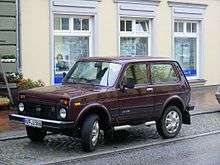
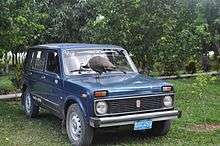
Initially, the Niva had a normally aspirated 1.6-litre overhead-cam four-cylinder petrol engine producing 56 kW (76 hp) and 126 N·m (93 lb·ft) at 5,000 rpm, a four-speed manual transmission (starting with new model from 1994, a 5 speed), and a full-time four-wheel drive. The drive system employs three differentials (center, front and rear). The transfer case involves a high/low range selector lever and a lever to lock the central differential. Low range can be selected with the center differential locked or unlocked. The original Niva had a maximum speed of 81 mph (130 km/h),[10] and can cruise at 56 mph (90 km/h) while consuming petrol at 8.25 L/100 km (34.2 mpg‑imp; 28.5 mpg‑US). Its towing capacity is rated for up to 860 kg (1900 lb).
Coil springs are located at each of the four wheels, and suspension is independent in front, whereas the rear axle is a 5 link live-type, with ratios between 3.90 and 4.30 depending on the model and market. Ground clearance is good at 235 mm (9.25 in) and water 510 mm (20 in) deep can be negotiated.
The brakes (disc front, drum rear) are servo-assisted dual-circuit style and the clutch is hydraulic. The turning circle is a relatively low 36.25'. Cargo space is 0.48 m³ (17 ft³), or 1.33 m³ (47 ft³) with the rear seats folded down and, like the classic Zhiguli, the front seats can be set up to make two berths (by removing headrests, shifting the seats into foremost position and setting the backrest in plane with the back seat – this feature later disappeared when the new model with different seats was introduced in 1994). A spare tyre is located in the engine bay under the bonnet. The latter feature is considered a useful and practical feature by off-road fans.
Additional equipment for basic model was rather simple and was equal to other Lada and generally Eastern bloc cars of the period, it included headlight wipers, rear fog lamp, right external mirror (right mirror for domestic models only since the export ones had both by default, however, at the end of 1980s even domestic models of all Lada cars also received both mirrors), then rear seat belts, rear (tailgate) window wiper, rear window heater and a radio set. On new model (Niva 1.7/VAZ-21213) starting from 1994, all those features except headlight wipers and rear fog lamp (which are discontinued) became default and optional is air conditioning, anti-lock braking system and hydraulic servomotor for the steering column, which are, now however, becoming parts of standard equipment on the newest models.
Foreign (usually Western) local Lada importers often also offered their own additional equipment (mainly for off-roading) prior to buying the car, such as front and rear bull bars and roll bars as well as side rocker rails, roof rails, winch, fender plastics and additional headlights for front bumper and for roof rails, which can be often seen mounted on many Nivas.
The existing model was slightly restyled during first half of 1980s, when VAZ for the first time discontinued one of its models, the VAZ-2103 (which was slowly being replaced with VAZ-2106 since 1975). Some of the chrome lined elements have disappeared in all future models due to high price and complexity of production, such as, in Niva case, the chrome lined mask and rocker panel edges which were removed, as well as external/side mirrors which became black metallic. Chrome even disappeared from ashtrays and door panel edges. Also, background of front Lada badge was changed to white (later black; on new model) on all models instead of red as until then. Rear Niva 1600 tailgate label, (which was originally located in the center of the tailgate), was relocated to its right corner due to rear window wiper which was, on buyer request, installed onto its former place as additional equipment. Side rear retroreflectors (or turn signals on some models; depended on market) were replaced by Lada (left) and Niva (right) labels and the rear mud flaps received the plant logo on them. Interior was only minimally changed, along with some minor changes to the instrument panel, choke knob and other details, probably the most notable difference is in its VAZ-2106 steering wheel, which was now decorated with classic Russian ornaments featuring the Lada logo on its central (leather) part.
Those pre 1985 models are visually best recognizable by mentioned details and are today extremely rare (in preserved condition almost non existent anymore) and due to that very valued by collectors.
The first generation (VAZ-2121 Niva, or Lada Niva 1600 as known commercially) was in production until 1993 (existing in parallel in production with new model until the end of the same year) when the new and more powerful (1.7 litre, 80 horsepower) four-cylinder petrol engine (designed purposely for Niva and thus, not used by any other VAZ model until then) was introduced, replacing the previously used (1.6 litre, 75 horsepower) VAZ-2106 engine and making the appearance of the new model (VAZ-21213/21214 or Lada Niva 1.7/1.7i), as was the carburetor replaced by single-point fuel injection supplied initially by General Motors on 21214/1.7i model and the usual Weber carburetor was replaced by improved Solex one on 21213/1.7 model. The transmission was changed from 4 to 5 speed, mechanical ignition was replaced with electronic and suspension received some relatively minor changes. Exhaust system was also slightly redesigned and, on newer models, the drive shafts received homokinetic joints instead of usual universal ones. Also, the exterior rear section of the body was redesigned with tailgate extended and license plate as a part of it (so it could have a lower opening, now bordering with the rear bumper), due to which it also received new, vertical taillights derived from VAZ-2104, replacing the former VAZ-2106 horizontal ones and VAZ-2102 chrome lined tailgate knob, which was replaced by a simple plastic handle. On newest models, the old hand adjustable, square black metallic (previously chrome lined) side mirrors, which were originating back from 1970s VAZ-2103 were finally replaced with larger plastic ones featuring automatic adjustment. The previous front Lada badge was also replaced with the current and larger one of ellipsoid design. However, the aging Fiat 125 chrome lined doorknobs are still present, although they are not chromed anymore on newest models, but plastic. Although the rest of the exteriors remained generally unchanged to this day (except for LADA 4×4 URBAN and BRONTO), the interior was, however, almost completely redesigned and shares only few interchangeable parts with the previous one; the archaic VAZ-2106 steering wheel with chrome elements was replaced with more modern and thicker one, firstly from VAZ-2107 and later even newer, as well as its VAZ-2103/2106 instruments, which were replaced with dashboard from VAZ-21099. The berth foldable, black artificial leather seats, which were also originating from VAZ-2106 were replaced by more modern and higher ones from VAZ-2108 with front surface made out of polyester (with which the berth feature disappeared), while the rear seat was improved to have easier folding. The old Fiat 124 swivelling windows from side doors disappeared and were replaced with air conditioning for that role, which is on request, (together with ABS and servomotor for the steering column) installed as additional equipment, while headlight wipers and rear fog lamp disappeared. It also received completely new front and door panels (with interior door knobs relocated above the handrests instead of under like on previous generation), various plastics and even new floor mats. The hand opening of side door windows was replaced with automatic on newest models (and on LADA 4×4 URBAN), starting from 2014. Multi-point fuel injection designed by Bosch is used currently since 2004, replacing the previously mentioned single-point injection from General Motors, which was used until then.
In 1993, the lengthened model of Niva also appeared, it was known as VAZ-2129 and was being produced very briefly (only for approximately a year) due to which it is very rare and was also never exported. Although having a much longer wheelbase, it retained usual 3 doors like the basic hatchback model (it only featured additional square middle window added at the sides), however, in design it was actually a hybrid of old and new generation, since it featured the old VAZ-2121 (Niva 1600) body and interiors combined with new VAZ-21213 (Niva 1.7) 1,680cc engine and 5 speed transmission (although later, 1994 production models featured even new body and interiors).
In 1995, the lengthened estate model with longer wheelbase and 5 door appeared, originally known as VAZ-2131 Niva, commercially it has no difference in name than standard (3 door) model, which is why it is often referred simply as Niva 5 door. Due to longer wheelbase and thus, increased weight, it can use even more powerful; 1.774cc inline four petrol engine, producing 63kW/85 hp. Although still in production like the basic model, It saw relatively limited use and is also slightly exported, mainly due to longer wheelbase and increased weight offering somewhat inferior offroad capabilities as well as slightly higher price when compared to the standard model. In 2015, the 5 door model also appeared for LADA 4×4 URBAN.
In 1999, a diesel engine model of Niva appeared for the first time, known as VAZ-21215 Niva or commercially as Lada Niva 1.9, which was produced until 2007 and sold only in few markets. It was powered by a 1,905cc Peugeot XUD 9SD inline four diesel engine, delivering 55kW/75 hp and was thus slightly less powerful than standard VAZ-21213/21214 1,680cc petrol engine (it was approximately equal in power to 1,568cc VAZ-2106 engine used by the previous generation). However, the VAZ-21215 was a relatively shortly lived model and is not available anymore due of the fact that, despite much lower fuel consumption, it was not very popular in domestic market (mainly due to harsh winter conditions, less power, lower reliability, higher price and maintenance costs when compared to the petrol engine model) as well as the fact that Peugeot stopped production of mentioned XUD engines back in 2001 (existing supplies were available until 2007 when the last VAZ-21215 came off production line) and VAZ never made another contract for production of diesel engine for Niva.
In 2006, the model with carbureted engine of new generation (VAZ-21213/Lada Niva 1.7) was discontinued and, in the same year, the name Niva was formally dropped in favor to new official name LADA 4×4 (although the former name was still being used in export markets at least until 2009 and it is still informally used world wide). This was done due to the fact that previously mentioned American General Motors company (which firstly supplied injection system to VAZ) got rights to the name Niva, which had to be discontinued in further production, together with old Soviet VAZ-2121 classification for domestic market, which was loosely abandoned by the plant itself back in the end of 1990s.
In 2014, the new, restyled model called LADA 4×4 URBAN appeared, with generally more modern looks resembling an ordinary SUV; new mask, plastic bumpers, new side mirrors, different (aluminium) rims (with original Soviet Voltyre VLI-5 offroad tires replaced with classic road tires), central brake light, heated front seats, airbags and slightly restyled interior. However, it did not replace the current LADA 4×4 (previously known as Lada Niva 1.7i, or VAZ-21214 for domestic market) which still remains parallelly in production with it.
In 2017, another model appeared; the LADA 4×4 BRONTO, intended firstly for offroad use. It features characteristic mask and plastic bumpers with integrated front and rear fog lamps as well as plastic roof rails and larger wheels with new, black aluminium rims featuring new; 235/75-R16 Bontyre Stalker domestically produced offroad tires, even higher ground clearance (increased for further 35mm) and plastic rust-protected body edges (fenders and rocker panels). Internally, it is similar to LADA 4×4 URBAN also featuring heated front seats and airbags. Additional equipment includes front winch, roof headlights and additional fog lights on front bumper. With all mentioned equipment included, the LADA 4×4 BRONTO is currently the most expensive LADA 4×4 model with current price of 720.000 RU in domestic market (around € 10.130). The slightly different pickup model designed by VIS was also revealed (featuring integrated metallic grille, different bumpers and a snorkel), called LADA BRONTO AMC, however, according to LADA official website, it is not serially produced yet due to the fact that it is not offered anywhere on sale.
On 5 April of the same year; at the car's 40th anniversary since the beginning of production, a special, limited edition of classic LADA 4×4 was presented, called LADA 4×4 40 anniversary, which was made in exactly 1977 copies (the year when Lada Niva appeared). It features new aluminium rims, (similar to LADA 4×4 URBAN) as well as 5 new color shemes, 40 anniversary metallic labels on fenders, tailgate and internally on glove compartment cover, front seat backrests and on floor mats. Also, it has slightly restyled interior featuring genuine leather seat upholstery and steering wheel cover as well as sills made out of stainless steel. The model is available from June 2017 on both domestic and export markets.
A soft top version appeared back in 1983, however it was neither serially produced nor designed by its native VAZ, but was actually just a modification of the original Niva 1600 (2121) bodied by French coachbuilder Wassermann for the local market.[3] This was known as the Niva Plein Soleil (Sunlight) and was just one of many Niva modifications made by local importers for their markets. (Lada Cossack, Hussar and Lada Taiga as an example, were modifications for British and West German market).[12]
Cossack
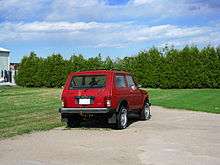
During the 1980s local Lada importers in various markets made their own upgrades to help compete with more modern SUVs. In the UK the Cossack model featured large body decals, roof rails, running boards, 15" alloy wheels, and on some versions a sunroof, steel bullbars, spotlights, a rear-mounted spare tyre and semi-bucket seats. Other markets' importers made similar upgrades and many were also called Cossack.
In 1995, Lada UK introduced a face-lifted version of the Niva Cossack and renamed the basic model as the Hussar. Whereas the Hussar had the original 1977 trim, the new UK Cossack featured a new Rover-designed grille and other body kit items, and gained soft nudge-bars at the front in deference to public opinion against bullbars. Both models received the same new 1.7-litre engine and a new deeper tailgate which extended the rear opening to the level of the bumper – a vast improvement over the original model's high lip. Official Niva imports to the UK ceased in 1997 due to the importers having difficulty in sourcing the GM fuel injection unit required to satisfy ever-tightening UK emissions regulations.
There were several attempts to reintroduce Ladas back into the UK. In May 2010, the basic Niva became available again, through an independent importer. Aimed largely at the agricultural market, three models were made available (all LHD), the 3-door 4-seat hatchback at £10,000, a 2-seat commercial van, £8000 and a 2-door, 4-seat pickup for £12,000. All meet the current UK Vehicle Certification Agency standards. The only engine available is the 1.7 litre petrol, but this can be provided with or without a LPG conversion.[13]
VAZ-2122 Reka

Although the VAZ were meant exclusively for production of passenger cars and thus, the Niva was intended to be a strictly civilian vehicle, the Soviet military was truly astonished by its fascinating offroad capabilities so that it ordered its military version to be created from VAZ, which could replace the currently used UAZ-469 as standard military 4×4 vehicle. In 1976, when VAZ-2121 development was almost finished, engineers from Tolyatti began working on an amphibian off-roader, which became known as VAZ-2122 Reka ('River'), using completely different and, naturally, tougher body of a usual military vehicle (with a classic feature of spare wheel located on the back of the body instead in the engine compartment like on a classic Niva) in combination with ordinary Niva chassis and wheels, together with its permanent four wheel drive system (transfer case and lockable central differential) and mechanics in general, which was intended to be sold to the Soviet Ministry of Defense. Despite having a more rugged body, it weighted approximately as same as the usual Niva, however, instead of 1,600cc (55kW/75 hp) VAZ-2106 engine which Niva had, it used older and less powerful 60 hp (45 kW; 61 PS) 1,300cc engine derived from VAZ-2101 instead, with a lower top speed of 71 mph (114 km/h) on road or 5 kn (5.8 mph; 9.3 km/h) on water. Internally, it featured a different, metallic front panel, although it used the same Niva instruments along with the same steering wheel and artificial leather seats.[14]
Six different evolution prototypes were built, and much of development work was done. The car was tested in an experimental military unit, on the proving grounds of the Ministry of Defense, and in the Turkmenistan Karakum Desert. VAZ-2122 showed better results than then currently used UAZ-469, (especially the fact that it featured amphibious capabilities which UAZ did not have) and received very positive feedback; military was satisfied with its capabilities as well as its reliability, firmness and durability. By 1987, VAZ had finished all development work, and the car was ready for mass production and military service.
However, at the end of the 1980s, the Ministry of Defense did not have the financial resources necessary for large-scale purchases of the VAZ-2122 as well as the fact that it also had some other higher priority projects to invest in, such as Tor mobile anti aircraft system, T-80U battle tank, BMP-3 infantry combat vehicle, BM-30 Smerch multiple rocket launcher, 2S19 Msta self-propelled artillery and other. As a result, Reka was never put into mass production and remained only in a prototype stage, despite the success in trials and the fact that more than 10 years were invested in its development.
LWB Nivas
.jpg)

Longer wheelbase versions – the five-door VAZ-2131, three-door VAZ-2129 and the VAZ-2329 pickup, were also produced from 1990s,[15] but not generally exported.
Nameplate changes
The Lada Niva was formally renamed LADA 4×4 back in 2006 and it is continued to be offered with a low-range gearbox, differential lock, ABS, airbags, heated front seats, air conditioning, servomotor for the steering colomumn, underbody protection and more. Prices for the model started at €10,990. it is available in five body styles; 3 and 5 door hatchback as well as 2 and 4-door Pickup and van. Two petrol engines are available for the model; standard 1.7l as well as 1.8l (only for 5 door model, however) along with a 5-speed manual transmission.[16][17]
Starting 2014 model year, the "Niva" nameplate was discontinued for the Russian market, and the vehicle is currently branded as "LADA 4×4" for both short and long wheelbases. This was done to make way for the upcoming restart of the Chevrolet Niva series, which was slated to start production by March 2015. However, due to the current economic situation in Russia-West relations, AvtoVAZ analysts have suggested that the production of Chevrolet Niva may indeed get delayed furthermore into 2015, especially considering any upcoming automotive sanctions packages against Russia. AvtoVAZ currently plans in keeping the LADA 4×4/Niva for its domestic market, branding it as economy class SUV.
Safety by modern standards
In 2002 the Lada Niva was awarded zero stars out of a possible four by the modern Russian ARCAP safety assessment program. The reviewer noted the very rugged body of the car as the only positive aspect in terms of safety.[18] In the test, the passenger dummy was hit by the glove compartment hard enough to risk traumatic brain injury.[18]
The reviewers noted that they didn't expect a high rating and that the result was natural, as "it would be naive to believe that a 30-year-old design complies with modern requirements for passive safety".[19] They added it would require the car to be completely modernized in order to meet modern safety standards.[19]
Uses of the Niva
In Russia and Europe the Niva has been used as an ambulance, a military vehicle, and by various police forces and utility companies. It also saw service for a time as a vehicle for lifeguards on beaches in the Netherlands. In former Czechoslovakia, the Niva was used as a standard police car of their police ("Public safety"). Croatian Army was notable as being the only army which used Nivas (taken from civilians during the wartime) as their standard military 4×4 vehicle due to serious lack of proper military vehicles, such as UAZ-469 or GAZ-69 (which were also in use), until it was later replaced by British Land Rover Defender and Austrian Puch G, which are still being used today.
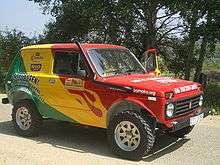
.jpg)
Transmanche-Link, the commercial consortium that built the Channel Tunnel between England and France, used a fleet of 45 Nivas to aid in the enormous project. Each Niva accumulated in excess of 70,000 kilometres (43,000 mi) off-road during its employment, and after construction had been completed in 1993, the fleet was sold off to a local dealer.
In Brazil, the Niva was the best-selling off-road vehicle during the early 1990s. In fact, the Niva was so cheap that even with the 85% importation value tax, it was less expensive than Brazilian competitors such as the Envemo or Gurgel. It sold so much more than the Gurgel Carajás, that Gurgel discontinued production in January 1991. The Niva was the first imported 4×4 in the Brazilian market, following then-Brazilian president Fernando Collor's decision to permit the importation of foreign vehicles in 1990. In the Brazilian market, a used 1991 Niva in good condition costs about R$11,000. Competition and higher importation value taxes forced the Niva to be retired from the Brazilian market. Even so, thousands of Nivas remain in use in Brazil.
Nivas have been driven on land, up mountains, through mud, and even underwater.
It was the first wheeled vehicle to spend more than ten years in Antarctica, where the classic VAZ-2121 Niva (Lada Niva 1600) was used by the Russian (formerly Soviet) Antarctic Expedition for transportation of personnel and goods, communication between Antarctic stations, towing boats and where it covered more than 40,000 km (24,855 miles) in the years 1990-2001 thus operating on temperature down to -54°. Niva also conquered the North pole in 1998, when the lengthened VAZ-2131 Niva (5 door model) was dropped via parachute on ice and successfully completed its route operating on average temperature of -30° and thus becoming the first wheeled vehicle to spend time there. Also, it had set the world record of highest point ever reached by a motorized vehicle when another VAZ-2131 climbed 5.200m high base camp on Mount Everest in 1998 and even higher just a year later; on 16th September 1999, when the similar Niva belonging to Saint Petersburg extreme expedition team reached a height of 5.725m on Tibet mountain during offroad. [20]
Assembly outside Russia
Car manufacturer Bognor in Uruguay assembled a version of the Niva, called Bognor Diva, released in 2004.[21]
In Greece, the Automeccanica car maker assembled different versions of the Lada Niva in the late 1980s and early 1990s, including an in-house developed cabrio version.[22]
Chevrolet Niva
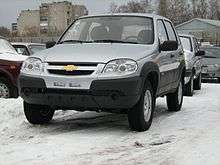
GM-AvtoVAZ, a joint venture between AvtoVAZ and General Motors, produces the Chevrolet Niva. (previously known as VAZ-2123 Niva in domestic market). It features an updated body and 1.7-litre gasoline engine with fuel injection. Although the body and the interiors are new, it is still based on the old VAZ-2121 engine, transmission and most mechanicals. Its off-road ability is exemplary compared with many modern budget SUVs, having been designed for tough tundra territory.[23]
Modifications
Short/Regular versions
- VAZ-2121 Niva (export name: Lada 4×4 Niva): basic three-door hatchback model with the engine VAZ-2121 (1.6 liter, 75 hp, 116 Nm) and 4 of Art. PPC. Several prototypes of the VAZ-E2121 was created in 1972-1975. At the end of 1976 released a pilot batch of "Niva". All the cars in this series are painted in the color "Gold Ochre" and headlamp cleaning different location – sticking out from the front and not from the grill, as in mass-produced cars. Standard model was performed from April 1977 to the end of 1993, existing on the line parallel with the new model 21213 for six months;
- VAZ-21211 (Lada Niva 1.3): export version of the engine 21211 (adapted engine VAZ-21011 1.3 liter, 69 hp, 92 N · m). Made since 1978 for countries with higher taxes on engines of more than 1.5L (mainly the Benelux countries and Southern Europe). Only saw limited demand due to reduced power and torque.
- VAZ-21212 (Lada Niva 4×4): right-hand drive export modification. Made in limited quantities, especially for the British market and also sold in Australia, New Zealand, and as the "Neve" in Japan;
- VAZ-2122.600 "The River": Army amphibious vehicle using aggregates VAZ-2121. In the 1976–1985 years. developed several prototypes of amphibians with utilitarian open sealed 2-door body. In 1987 the revised model VAZ-2122.600 "The River" was the state tests, but the standard was not made because of amphibian conversion ;
- VAZ-21213 (the original name of "Taiga" did not stick) – restyling model "Niva" in 1993 with the revised rear end with a low loading height (another form of the rear doors and rear lights), more powerful and high-torque engine VAZ-21213 (1.7 L, 81.8 hp, 125 Nm) with a Solex carburetor and contactless ignition system on the microcontroller (and that both reduces fuel consumption and improves the flow of oil), Silumin radiator, and many others. In 1993, the transition game was released with a standard engine VAZ-2121.
- VAZ-21214 (LADA 4×4): modification of the model 21213 with the engine VAZ-21214 (1.7 L, 81.8 hp, 127.5 N · m) equipped with central fuel injection. Since 2002, this model is set engine VAZ-21214-10 (Euro-0) with fuel injection, upgraded in 2006, under the norms of Euro-2 (21214-20), in 2008 under the Euro-3 (21214-30), and finally, in 2011, under the norms of Euro-5 (for export) and Euro-4 (for home use). C 2006, in accordance with the agreement on the joint venture GM-AvtoVAZ renamed LADA 4×4 3-dv. At the end of 2008, the first rumors about the next update LADA 4×4 – LADA 4×4m. Changes were protracted. The first steps were taken in early 2009, and finally the development of upgrades was completed in late 2011. Changed the interior and exterior lighting devices, upholstery, transmission units. Part of the components is unified with the project Chevrolet Niva.
- VAZ-21215: export version with the Peugeot XUD 9SD diesel engine, originally produced in 1999-2007. This version was fairly short lived.
- VAZ-21216: export version of the model 21213 with the right wheel and carburetor engine VAZ-21213;
- VAZ-21217: export version of the model 21213, with the engine VAZ-2121 (1.6L);
- VAZ-21219: reduction combined with body modification and suspension of the VAZ-2121 and 1.7-liter engine and the transmission of the VAZ-21213. Made in 1993-1994.
- VAZ-2121B: of armored car based on the VAZ-2121. It was created in 1992 by experts VAZ subsidiary company of JSC Special Production Cars Bronte Produced in a limited edition from 1992-1993. Served as a starting point for creating a family of armored vehicles, "Bronte Force."
- VAZ-2121F: export commercial version of model-based VAZ-2121 and 21213 with a body such furgonet.
- Lada 4×4 Urban — version of the base 3-door car. It has new bumpers, grille and steering wheel, there are some addition to the options list: power and heated mirrors, power windows, air conditioning and alloys. The car produced by VIS-Auto since October, 2014.[24]
Long versions
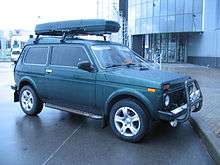
- VAZ-21218 "Fora": extended by 300 millimetres version of the model 21213. Short-run was performed from 1996 to 2011 by "PSA Bronto" (code "X7G"). It differs from the basic model increased the width of doors and doorways, raised by the add-back of the plastic part of the roof and a wider rear triple seat type 2108. The standard equipment of "odds" enable automatic fire extinguishing system in the engine compartment of an armored car "Force", and for a fee – power steering, air conditioning and a plastic bull bar in front of the radiator grille. Due to the use of larger diameter wheels (alloy wheels Togliatti by "Slick" with "Nokian HRC" tyres) "reserve" taken out of the engine compartment and is secured over the rear bumper.
- VAZ-212182 "Force": armoured version of the model VAZ-21218 produced by PSA Bronto . In addition to the booking system is additionally equipped with an automatic fire extinguishing system in the engine compartment, fuel tank explosion and fire, extra battery, air conditioning, remote control door lock, right from the driver seat. As additional equipment is offered armored floor, and warning beacons, etc. Since the "Force" to 430 kg heavier than the "odds" are applied suspension springs of larger diameter rod and reinforced shock absorbers;
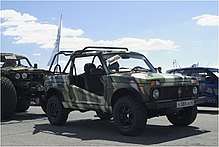
- VAZ-212183 "landole" (Lan-doe-lay): outdoor beach buggy SUV based on the "odds" with a body like " Lando "or" landole. " Produced PSA Bronto individual orders since 1997. The lack of a roof and door pillars offset original power roll cage, which, if necessary, fixed light tent or mounted brackets for transportation of bulky sports equipment. Tailgate swings to horizontal loops. Easy-to-wash interior (seats upholstered in imitation leather, the floor is covered with a soft linoleum). Exterior complemented by original plastic "underweight" and two-tone colouring.
- VAZ-2129 ("Cedar"): extended by 500 mm model is based on a standard VAZ-21213. "Cedar" was created in the early 90s as the carrier units for prospective minivan VAZ-2120, but in 1992-1994. produced in small series for OPP AvtoVAZ. Body lengthened at the expense of the central insert. Served as the basis for a five-door model VAZ-2131;
- VAZ 2129 "Utiliter": a commercial modification of the "Cedar". It differs from the basic model the lack of rear seat and barred from the inside rear side windows. The piece was manufactured under an order for OPP AvtoVAZ and distribution has not received;
- VAZ-2130 ("Cedar"): modification of VAZ-2129 with a reorganization of the interior. Three-seat bench type 2108 is shifted forward. According to unconfirmed information, then the index of the model was changed to 2129-01. VAZ-2130 was made in small batches in 1993-1994. Served as the basis for a five-door model VAZ-2131-01;
- VAZ-2131 (LADA 4×4 5-doors.): Extended by 500 mm five-door model on the basis of units of VAZ-21213. Available in the pilot production of AvtoVAZ (OPP AvtoVAZ) since 1993. VAZ-2131 is based on the model 2129 "Cedar" by adding a pair of rear doors. On February 2009 has already produced 100 thousand VAZ-2131 [14], making this the second most popular model in the family of the old "Field". Lengthening the body is produced by the central 500-mm insertion into a standard body model 21213. Accordingly, changes wheelbase and length of the car. On the 2131 version of the distance between the front and rear seats is increased by 125 mm, and applied to the 2131-01 three-seat bench type 2108. The fuel tank is enlarged to 65 liters. With the development of a PPO production engines of VAZ-2130 (1.8 liter, 84 hp, 132 Nm), 21312 version made with this engine. Because of the typical appearance of love and manufacturers to green, VAZ-2131 in the people got the nickname: crocodile
- VAZ-2131 SP (213105/213145): model manufactured at the OPP VAZ ambulance on the basis of the VAZ-2131. Differs increased by 300 millimetres rear overhang and high plastic roof. A characteristic feature of the exterior of this car is that there are two doors on the right side and one on the left. Due to the increased volume of the luggage compartment allows you to carry a patient on a stretcher and two accompanying physicians with a set of equipment. VAZ-2131-45 is the version produced by OSC Motility, an autovaz subsidiary, which has a stepped roof.
- VAZ-213102: model manufactured at the OPP VAZ "civil" 5-door version of the health model VAZ-213105. Located in the same increased by 300 millimetres rear overhang and high plastic roof, but was equipped with a conventional five-seat saloon. Increased to 1900 liters luggage compartment allows you to put in it two extra seats that turned the car in the 7-seater (and translates it into a class of medium-sized SUVs). VAZ-213102 produced on demand in 1999-2003.
.jpg)
- VAZ-2121 sugar 1 small-sized saloon "Niva" forced to think about lengthening the machine. In this way, at the end of the 80s were trying to go at the plant, and some designers enthusiasts. That's such enthusiasts in 1991, it was created six copies elongated "Niva" with the increased height roof. Part of the machinery of the party is registered as homemade, fell into private hands, and the part was bought "Lada-bank" as a service and is issued under his own name "Sahara". Further developments on this machine were used to create extended versions of VAZ-2129 "Cedar" and VAZ-21218 "Bronto".
- VAZ-21317 front wheel drive electro car.[25]
Vehicles based on the Niva
- VAZ-2120: «Фора» Hope Minivan based on LWB Niva[26] The Hope is a 3 (4) -door minivan first shown in 1996. Production began in 1998, and two years later began a steady release of one and a half thousand cars a year.
- VAZ-21204: 3 (4) -door minivan. An updated version of the front optics of the VAZ-2110 was first introduced in 2000, but small-scale production began only two years later. Also known under the symbol WHA 2120M. Total from 1998 to 2005 was released 8570 minivans (according to other sources – about 7000).
- VAZ-2123: Russian compact SUV a second-generation pilot batches which were produced by the WHA in 2001-2002. Preserved the continuity of the old "Niva" in aggregates and after considerable modernization was launched in mass production in September 2002, at the facilities of the joint venture GM-AvtoVAZ as the Chevrolet Niva . Part of the units of Chevrolet Niva (e.g. WTP firm ZF) eventually moved to LADA 4×4;
- VAZ-2129: a 2-door model with long wheelbase. The 2129 is built in small numbers since 1993;
- A variation is the 212901 1800s with a carburetor engine and two 42 liter tank, the 212901 thus has a tank capacity of 84 liters.
- VAZ-2328 "Wolf": pick-up with a short 2-person cabin on the base model VAZ-2131. Had to get up on the pick-up in parallel with the production of VAZ-2329, but due to low demand "LADA-Toole," released only the initial batch of "Wolves";
- VAZ-2329 "Bear", "Niva Pick-up", LADA 4×4 Pickup: pick-up with an extended five-passenger cab model based on VAZ-2131, short-run manufactured by OPP VAZ. The car retained the bearing body (wheelbase 2700 mm) with a reinforced base and differs increased by 300 mm rear overhang. Load capacity is 650 lbs. On the VAZ-2329 retained the mechanical part of VAZ-2129/2131. Under the order instead of the engine VAZ-21213 was possible to install the engine VAZ-2130 (1.8 liter, 84 hp)., An additional fuel tank, bringing their total capacity to 84 liters. The rear seat in the cockpit of the original, when folded flat, forming the cargo area. The first issues were of his own pickup truck called the "Bear";
- VIS-2346: the family of pickup trucks with poluramnym chassis on the basis of units of "Niva" Togliatti production company "VAZInterService" produced from 1996 to the present, short-run release two versions of a pickup truck: VIS-2346 with a short two-seat cockpit and VIS-23461 with an extended 5 – the local unit. Formerly produced as pickup VIS-23464 with a queen-size four-seater cabin and a pickup VIS-2348 with the cab of the LADA Samara 2 . Reinforced rear suspension spring is made.
- Bronte-1922 "March 1": terrain vehicle ("pneumatic") on wheels for low pressure units VAZ-21213. Short-run is made of "PSA Bronte" from 1997.
- APAL-21541 "Stalker": modification on the basis of units and parts of VAZ-21214, was planned for series production at the plant "Pishchemash" in the city of Argun, Chechen Republic . Short-run is made, LLC "APAL" since 2003.
- CCF-2302 "Bison": pick-up chassis with frame on the basis of units of "Niva". Pickup truck with double cab and a short wooden platform short-run Togliatti produced by "Eastern Ring" in 1993-1995. Reinforced rear suspension "Buffalo" was a spring. Pick-up in demand did not use.
Versions by AvtoVAZ subsidiaries
Motility
LLC "motility" Versions:
- Minivan: Track front and rear wheels – as in "Niva", but the wheelbase has increased by half a meter. Machine length reaches 4.3 m, which allows you to put inside the three rows of seats. equipped with a gasoline engine carburetor: VAZ-2130 with a displacement of 1.8 liters, 80 hp In the future it is planned to install a new minivan to a two-liter engine, which is now being tested. Variants include:
- "Van": for the transportation of various large-sized cargo;
- "Service": the organization on the basis of the vehicle mobile workshops;
- "Manager": a special car for business travel business leaders;
- "Taxi": 4-seater with a spacious cargo area.
- Wagon: with a high roof and trunk increased in 2131 as opposed to 500 millimeters
- Ambulance: For regional and rural hospitals. Spacious and high interior due to the increased rear overhang and roof gives you the freedom to place the patient, health professionals and accompanying. The car body metal bearing, with four hinged doors, sidewalls and tailgate (CX-1). Beauty body is equipped with a platform for the installation of sanitary litter and as seats for the doctor and the accompanying passenger. Beauty body is equipped with an additional heater, located under the floor of sanitary stretchers. The driver and passenger are isolated from the rest of the interior of the car a solid wall with clear glass.
- Patrol: law enforcement and inspection version
- ECP: extended cab pickup
Bronto
PSA Bronto versions:
- 2 door Landole: outdoor beach buggy SUV The lack of a roof and door pillars offset original power roll cage, which, if necessary, fixed light tent or mounted brackets for transportation of bulky sports equipment. Tailgate swings to horizontal loops.
- Marsh series: swamp, snow and marsh buggies:
- Marsh 1: three door
- Long Marsh: 5 door
- Marsh pickup: extended cab pickup
- Marsh Rescuer: 4 door ambulance
- Marsh Combi: 5 door with fiberglass raised roof
- Marsh Fire: 2 door (fire and rescue)
- Lynx SUV: set screw type limited slip differentials in the front and rear axles, increased travel front and rear suspension wheels. On Niwa-LYNX installed reinforced front springs for increased ride height and reduce the dynamic loads from the blows. Strengthened rear axle NIVA-trot to prevent bending and raised rear support of the spring on 40mm to increase ground clearance. Arches wheel NIVA-LYNX modified for motion in the enlarged passages hangers, rubber arch extensions installed.
- Lynx 1: three door
- Lynx 2: five door
- Lynx 3: five door with fiberglass raised roof.
- Force: Armored Series
- LADA-BRONTO 213102 "FORCE CASH": five door with fiberglass raised roof.
- LADA-BRONTO 213102 "FORCE LONG": five door with flat roof.
- LADA-BRONTO 212 142 "Force K": three door with flat roof
- LADA-BRONTO 213102-771-40 "Force Divisional Commander": tactical version of five door with fiberglass raised roof.
- Ambulance: 4 door, one left, two right and back, with fiberglass raised roof.
VIS
VIS versions:
- LADA 4×4 Pickup
- LADA 4×4 Pickup DPS
- LADA 4×4 Ambulance: based on the extended five-door LADA 4×4 and improved possibilities for medical applications. The car body, compared to the usual long-base LADA 4×4 is increased in length by another 280 mm, which allowed the interior divided by a partition into the driver's cab and the medical department. The partition has a sliding glass window that allows the driver to communicate with the doctor or the patient in the medical cabin. The medical department may be equipped with a comfortable seat doctor folding table and chair stretcher (which loosely fits the patient in a prone position). It is possible to accommodate medical equipment (infusion bottles holder, gear-oxygen inhaler, medical ventilator, medical assistant set, set of tires transport folding). The roof of the car has a stepped design, increases smoothly from the driver's cabin to medsalonu.
The car can be equipped with a voltage converter 12 -> 220, to supply various medical equipment; additional electric heater med salon.
Notable owners
A notable Niva buyer in May 2009 was Russia's then-premier Vladimir Putin.[27] He flaunted his camouflage-painted Opel-engined offroader in the Russian media, allegedly to support domestic car producers despite the financial crisis.[28][29]
Serbian football player Aleksandar Kolarov received a certificate worth-a Lada 4×4/Niva, as a reward for a World Cup goal in its match against Costa Rica and its national team, during the Russia 2018 World Cup. [30]
Gallery
 Lada 2121 Tuner
Lada 2121 Tuner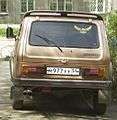 VAZ-2121 (first generation) "Niva" (rear view)
VAZ-2121 (first generation) "Niva" (rear view) Lada Niva front view
Lada Niva front view Lada Niva rear
Lada Niva rear.jpg) VAZ-2121 customized to cabriolet (side view)
VAZ-2121 customized to cabriolet (side view) VAZ-2121 customized to Truck.
VAZ-2121 customized to Truck.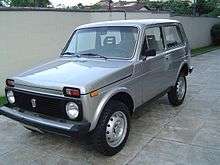 1991 Lada Niva in Brazil
1991 Lada Niva in Brazil.jpg) Lada Niva in France
Lada Niva in France.jpg) VAZ-2131 as a police car
VAZ-2131 as a police car.jpg)
- VAZ-2131 Engine
- VAZ-2131 Dashboard
See also
References
- ↑ Lada Australia advertisement for Lada Niva and Lada Bushman, Wheels (magazine), April 1997
- ↑ "Ao"Азия Авто"". Aziaavto.kz. Archived from the original on 16 January 2011. Retrieved 1 February 2011.
- 1 2 Thompson, p.238.
- ↑ "Новая Шеви-Нива: разморозка". Autostat.ru. Archived from the original on 14 December 2017. Retrieved 13 December 2017.
- ↑ "Icelandic Automobile Association". Fib.is. 2011-07-21. Archived from the original on 2013-11-10. Retrieved 2013-12-27.
- ↑ Thompson, Andy. Cars of the Soviet Union (Haynes Publishing, Somerset, UK, 2008), p.239 caption.
- ↑ "A quick look at the Lada Niva". Ran When Parked. Archived from the original on 2012-01-14.
- ↑ Thompson, Andy. Cars of the Soviet Union (Haynes Publishing, Somerset, UK, 2008), p.180.
- ↑ Thompson, pp.185-186.
- 1 2 3 4 5 6 7 8 Thompson, p.187.
- ↑ Thompson, p.caption.
- ↑ Thompson, p.241 caption.
- ↑ David Cousins. "Farmers Weekly". Fwi.co.uk. Archived from the original on 24 November 2010. Retrieved 1 February 2011.
- ↑ Thompson, p.189.
- ↑ "Niva allroads models". RusLada.com. Archived from the original on 15 July 2011. Retrieved 14 February 2011.
- ↑ "Russian Lada Niva is renamed Lada Taiga – News Feed – Kazakhstan news today". Bnews.kz. Archived from the original on 2013-12-27. Retrieved 2013-12-27.
- ↑ "Lada Niva is renamed as the Lada Taiga". Inautonews.com. 2013-05-22. Archived from the original on 2013-12-27. Retrieved 2013-12-27.
- 1 2 "Лада ВАЗ-21213 Нива". Авторевю. Archived from the original on 11 February 2017. Retrieved 1 June 2017.
- 1 2 "Краш-тест ВАЗ-2121 // Авторевю, №19, 2002 г." Archived from the original on 2017-07-12.
- ↑ "1990 ВАЗ-2121 «Нива»". 360carmuseum.com (in Russian). Archived from the original on 2015-11-18.
- ↑
- ↑ "Automeccanica Αebe". Archived from the original on
|archive-url=requires|archive-date=(help). Retrieved 10 October 2011. - ↑ https://web.archive.org/web/20110104222747/http://www.gm-avtovaz.ru/new_en/inside.php?page=contents%2Fnew
- ↑ "Lada 4x4 Urban Production Begins". Wroom.ru. 2 October 2014. Archived from the original on 7 October 2014. Retrieved 7 October 2014.
- ↑ "Niva allroads models". Ruslada.com. 2001-06-27. Archived from the original on 2016-03-04. Retrieved 2015-08-22.
- ↑ "ВАЗ 2120 "Минивэн"". Motorica.ru. Archived from the original on 2015-07-21. Retrieved 2015-08-22.
- ↑ Putin flaunts new Lada Niva Associated Press in Moscow, used by New Zealand Stuff.co.nz news portal, 18 May 2009.Retrieved: 4 September 2014.
- ↑ Putin Pimps His Russian-Made Ride With German Engine Associated dispatch quoted by Moscow Times, Moscow, 27 January 2010 Archived 4 March 2015 at the Wayback Machine..Retrieved: 4 September 2014.
- ↑ , Andrew Osborn in Moscow, Daily Telegraph, London, 26 January 2010 Archived 22 July 2014 at the Wayback Machine..Retrieved: 4 September 2014.
- ↑ "Serbia's Kolarov given car for World Cup goal". Channel NewsAsia. Retrieved 2018-06-19.
External links
| Wikimedia Commons has media related to Lada Niva. |
- Official Lada Niva page at Lada.ru
- UK and Ireland Importer
- Chevrolet Niva website
- Lada Niva technical manuals
- Baxter's Temple of Niva, a large collection of resources for Lada Niva owners
- Bronto PSA official page
- Motorica (aka Motility) official page
- Lada Niva in Bulgarian
| Type | 1970s | 1980s | 1990s | 2000s | 2010s | ||||||||||||||||||||||||||||||||||||||||||||
| 0 | 1 | 2 | 3 | 4 | 5 | 6 | 7 | 8 | 9 | 0 | 1 | 2 | 3 | 4 | 5 | 6 | 7 | 8 | 9 | 0 | 1 | 2 | 3 | 4 | 5 | 6 | 7 | 8 | 9 | 0 | 1 | 2 | 3 | 4 | 5 | 6 | 7 | 8 | 9 | 0 | 1 | 2 | 3 | 4 | 5 | 6 | 7 | ||
| City car | Oka | ||||||||||||||||||||||||||||||||||||||||||||||||
| Supermini | Kalina | Kalina | |||||||||||||||||||||||||||||||||||||||||||||||
| Granta | |||||||||||||||||||||||||||||||||||||||||||||||||
| Compact car | 1200/1300 | ||||||||||||||||||||||||||||||||||||||||||||||||
| 1500 | |||||||||||||||||||||||||||||||||||||||||||||||||
| 1600 | |||||||||||||||||||||||||||||||||||||||||||||||||
| Riva/Nova | Largus | ||||||||||||||||||||||||||||||||||||||||||||||||
| Samara/Sputnik | Samara | ||||||||||||||||||||||||||||||||||||||||||||||||
| 110 / 111 / 112 | |||||||||||||||||||||||||||||||||||||||||||||||||
| Priora | Vesta | ||||||||||||||||||||||||||||||||||||||||||||||||
| Minivan | Nadezhda | ||||||||||||||||||||||||||||||||||||||||||||||||
| Off-road | Niva / 4x4 | Taiga | |||||||||||||||||||||||||||||||||||||||||||||||
| Crossover | Xray | ||||||||||||||||||||||||||||||||||||||||||||||||